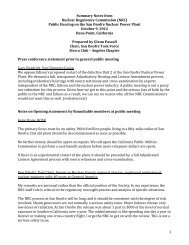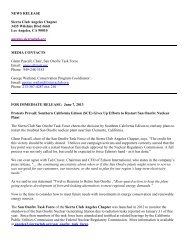Southern Sierran - Sierra Club - Angeles Chapter
Southern Sierran - Sierra Club - Angeles Chapter
Southern Sierran - Sierra Club - Angeles Chapter
You also want an ePaper? Increase the reach of your titles
YUMPU automatically turns print PDFs into web optimized ePapers that Google loves.
Poseidon misadventure: Desalination isn’t the way to go<br />
By Ray Hiemstra<br />
Many people in <strong>Southern</strong> California think<br />
that we are in a perpetual drought and will<br />
not have enough water to sustain ourselves.<br />
Unfortunately, this common fear is fueling<br />
misguided support for ocean desalination, the<br />
process of removing salt from seawater to create<br />
potable water.<br />
Our fresh water supply is often wasted and<br />
underutilized, especially when 60% percent<br />
of the water we produce goes towards landscaping<br />
purposes, not human sustenance. We<br />
need to use what we have wisely, and consider<br />
innovative, cost effective and environmentally<br />
friendly supply options.<br />
There are currently 16 proposed desalination<br />
plants in California, and the idea<br />
is spreading. Desalination is the most<br />
environmentally damaging, energy intensive<br />
and expensive water supply option.<br />
In Huntington Beach, Poseidon Resources,<br />
a Connecticut-based corporation, plans to<br />
privatize a public good, and use outdated<br />
technologies to make a profit at the expense<br />
of ocean ecosystems and ratepayers wallets.<br />
Poseidon has never successfully built a large<br />
desalination plant before; they have only<br />
demonstrated that they are good at making<br />
closed-door deals.<br />
Poseidon plans to use open ocean intake<br />
pipes, which the State of California has<br />
required all coastal power plants to discontinue<br />
using by 2020. Open ocean intakes<br />
suck in and kill billions of fish eggs, adult fish<br />
and other marine life. Not only is desalination<br />
harmful when taking water in, but also<br />
when it expels hyper saline brine, the salt byproduct<br />
of the desalination process. In addition<br />
to a very high concentration of salt, brine<br />
also contains other pollutants such as heavy<br />
metals that can bioaccumulate throughout<br />
the food chain.<br />
According to a study by the Pacific Institute,<br />
“direct discharges into estuaries and the ocean<br />
disrupt natural salinity balances and cause<br />
environmental damage of sensitive marshes<br />
or fisheries.” The brine discharge from the<br />
Poseidon plant will cause a dead zone off the<br />
coast of Huntington Beach.<br />
Desalination not only harms marine<br />
resources, but it also affects our climate<br />
through increased greenhouse gas (GHG)<br />
emissions. Desalination is the most energy<br />
intensive water supply option. The Poseidon<br />
Huntington Beach plant would use enough<br />
energy to power 30,000 homes. Twenty percent<br />
of California’s cumulative energy demand<br />
goes to moving and treating water.<br />
In a 2008 report, the California Air<br />
Resources Board noted that a way for the state<br />
A desalination plant in Tampa Bay, Fla.<br />
to reach its reduced GHG goals is to replace<br />
existing water supply and treatment processes<br />
with more energy efficient alternatives.<br />
Desalination is a step in the wrong direction<br />
if we want to reach this goal.<br />
A recently approved Poseidon desalination<br />
plant in Carlsbad was originally estimated to<br />
cost around $250 million; now it is nearly a<br />
$1 billion project. The water to be produced<br />
at the plant costs 4 to 8 times more than other<br />
water sources such as groundwater or recycled<br />
water. And rate payers are bound to a 30- year<br />
contract to buy the water.<br />
Exploring other options<br />
Desalination may be one of the tools that<br />
water agencies and the public choose to<br />
pursue in the future but not before fully<br />
exploring and adopting the less expensive and<br />
proven options such as promoting water use<br />
efficiency, or funding the expanded use of<br />
recycling systems such as the Ground Water<br />
Replenishment System in Fountain Valley.<br />
The system takes highly treated wastewater<br />
that would have been discharged into the<br />
ocean and purifies it at a very affordable<br />
rate. In fact, the cost of water, per acre-foot,<br />
produced at the replenishment system costs<br />
one-third of what distributed water produced<br />
from a desalination plant would cost.<br />
Capturing urban runoff from the many<br />
high volume creeks and streams throughout<br />
the region, which dump hundreds of millions<br />
of gallons of polluted water a day into the<br />
ocean, is a viable and cost-effective alternative.<br />
Richard Atwater, Executive Director of<br />
the <strong>Southern</strong> California Water Committee<br />
recently stated that <strong>Southern</strong> California needs<br />
to “recognize the importance and potential of<br />
stormwater as a supplemental water supply<br />
source to what we currently import”. Much<br />
of this water should be captured and recycled<br />
to provide indirect potable water and reduce<br />
pollution to our ocean, which is required by<br />
law anyway.<br />
Another flaw of building a desalination<br />
plant in Huntington Beach is that the Orange<br />
County Sanitation District releases millions of<br />
gallons of secondary treated water a day into<br />
the ocean less than a mile from the site for the<br />
desalination plant.<br />
Why treat wastewater, release it into the<br />
ocean, then spend $1 billion to build a plant<br />
that sucks that same water back in just to take<br />
the salt out of it? The water coming out of<br />
the sanitation district’s facility is already being<br />
treated at a level that it could be used as an<br />
indirect potable water source to expand the<br />
Ground Water Replenishment System.<br />
Reclaimed water can cut use<br />
Water reuse can help better utilize our current<br />
water supply, but we can also implement<br />
more conservation measures on the demand<br />
side. A cost-effective example is the move<br />
some cities are making to stop using potable<br />
water for landscaping. Reclaimed water is<br />
clean and safe enough to be utilized for irrigation.<br />
With the elimination of overwatering and<br />
the use of modern landscaping featuring<br />
California Friendly vegetation, we can drastically<br />
reduce the amount of water needed for<br />
landscaping and use the saved water for people<br />
and industry. The resulting water savings<br />
would help protect our current water supply,<br />
save ratepayers money, and reduce the need to<br />
create, or import more water.<br />
The <strong>Sierra</strong> <strong>Club</strong> realizes that desalination<br />
is a necessary option for the future, in regions<br />
that have exhausted all other options. What<br />
we are opposed to is using destructive 1960s<br />
technology that destroys our fish stocks and<br />
pollutes our ocean. Other countries have<br />
implemented desalination as a last resort when<br />
all other options have been tried. Hopefully<br />
California will do the same. The Poseidon<br />
Huntington Beach project will be the turning<br />
point on desalination is done in California<br />
and your help is needed. Watch for messages<br />
from the <strong>Sierra</strong> <strong>Club</strong> <strong>Angeles</strong> <strong>Chapter</strong> regarding<br />
opportunities to send in letters or attend<br />
meetings to stop Poseidon and protect our<br />
environment.<br />
Ray Hiemstra is the Orange County Conservation<br />
Committee Chair for the <strong>Angeles</strong> <strong>Chapter</strong> <strong>Sierra</strong><br />
<strong>Club</strong>.<br />
SOUTHERN SIERRAN APRIL-JUNE 2013 7








